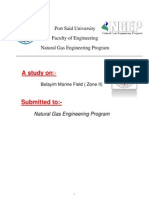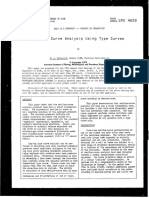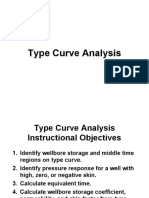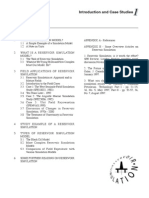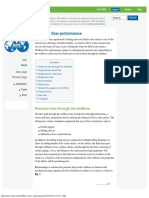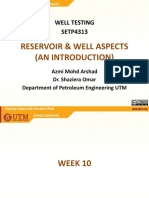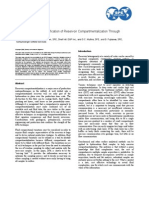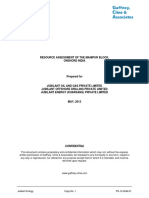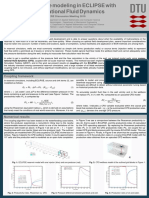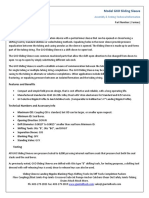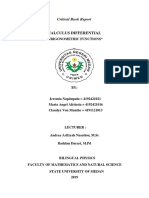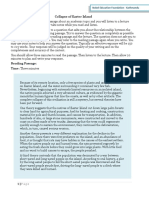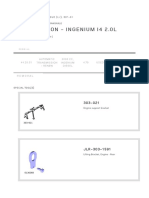Basic
Surveillance
Using Pressure-Transient Data to
Monitor Well & Reservoir
Performance
16/01/19 1
� Basic
Surveillance
• An oil or gas field requires surveillance of
individual well behaviour to identify
potential problems and opportunities to
improve performance.
• The objective of “Basic Surveillance” is to
answer the following two questions:
has the well-performance changed?
has the reservoir pressure deviated from the
expected trend?
16/01/19 2
�Basic Surveillance & Well-Test Analysis
• Over the life of a well, there will be opportunities
(planned or otherwise) to carry out a shut-in and
measure a pressure-transient response.
• Analysis of each set of pressure-transient data
can be used to help answer the two “Basic
Surveillance” questions:
compare “Derivative plots” to identify changes in well
performance
compare “Superposition Plots” to track changes in the
reservoir pressure.
16/01/19 3
� Basic Surveillance
Spreadsheet
• The “Basic Surveillance” spreadsheet is intended
to replace specialised well-test software when
carrying out Derivative and Superposition plot
calculations and comparisons.
• All formulas and source-code are “open” to allow
users to see how these calculations are done.
• The spreadsheet can be modified to include
customised calculations and summary sheets
• Download from www.welltestsolutions.com
16/01/19 4
� Demo - Spreadsheet
Layout
PVT & Units: define the test-type and the units for
the comparison plots. Also sets the
PVT data for gas-wells. Note the units
table has a row to set custom units.
PBU: each shut-in uses one of these sheets
which previews each plot, and sets a
line to estimate parameters. The input
units and test-type for each shut-in
can be set independent of the
comparison plots setting.
16/01/19 5
� Surveillance over the Well History
2004/02/18-1418 : OIL
2150.
pressure PSI
2050.
1950.
New “PBU”
0. Sheet
500. 1000. 1500. 2000. 2500. 3000.
New “PBU” Sheet New “PBU” Sheet
in Workbook
6000.
rates STB/D
-2000.
0. 500. 1000. 1500. 2000. 2500. 3000.
Time (hours)
16/01/19 6
� Demo - Enter Data for a
PBU
• duplicate the blank “PBU” sheet and re-name
This name is used for the comparison plot legend
• Select the test-type/units and fill in the static-data
• click on the “Edit Test Data” button
This turns off the calculations to allow EXCEL to work
faster and avoid unnecessary sheet updates.
• copy & paste the rate data
• copy & paste the pressure data
• Note: rate and pressure data must use the same
time format (e.g. date) and time basis.
16/01/19 7
� Superposition Plot
Assuming radial-flow and given an arbitrary rate-history
with “n” rate-changes prior to a shut-in, the “Superposition
Plot” can be represented by the following equation:
B n
p( t ) P* 162 .6 qi qi1 log t t n t i Note: rate “qi”
starts at time “ti”
kh i1
P*
Pressure data that reflects
radial-flow in the reservoir
Pressure during SI
will show a straight-line on m =162.6 Bµ/kh
the Superposition Plot with
slope “m” and intercept “P*”
Note that “P*” is a fictitious value
with no physical meaning! This
pressure does not exist 0. 100. 200. 300.
anywhere in the reservoir! Superposition(q(t),Δt)
16/01/19 8
� The Derivative Plot
Two special transforms of the data are
plotted together on log-log scales:
“Delta-p” curve
0
10
-1
10
“Derivative” curve
-2
10
10 -2 10 -1 10 0 10 1 10 2
16/01/19 9
� Derivative-Plot “Derivative”
Curve
dp
(derivative )
d Superposit ion q( t ), t
Pressure during SI
10 0
10 -1
0. 100. 200. 300.
10 -2
Superposition(q(t),Δt)
10 -2 10 -1 100 101 102
Superposition Plot Derivative Plot
16/01/19 10
� Derivative-Plot “Delta-p”
Curve 80/12/11-1400 : N/A
p(Δt)
4950.
p(Δt=0)
Note the rate
Pressure during SI
4900.
normalisation...
“delta-p” = (p(Δt)-p(Δt=0))/q
4850.
Δt
4800.
shut-in
100. 120. 140.
Time (hours)
160. 180.
16/01/19 11
� Derivative Plot
Features
The “derivative plot” reflects the completion and
reservoir parameters that control well performance.
0
10
proportional
to a “skin”
-1
characteristic
10
shape derivative “stabilisation”
= straight-line on superposition plot
and yields a permeability-thickness
-2
10
10 -2 10 -1 10 0 10 1 10 2
16/01/19 12
� The “Half log-cycle” Rule
“Ignore any feature in the derivative curve
that spans less than half a log-cycle along
the time axis.”
a stabilisation, linear trend, “hump”, or
“dip” must span at least half a log-cycle
before being considered significant.
any feature that fails this test is completely
unrelated to the reservoir characteristics.
No further explanation is required.
16/01/19 13
� Demo - Set-up Analysis Plots
• Select “Begin Analysis” button
• Select “SI Start” button and slide red marker to start
of the shut-in.
Note zoom function and importance of finding exact start
to get right derivative “delta-p” curve.
• Select “SI End” button and slide green marker to
the end of the shut-in.
• Select “Set KH” button to display derivative plot.
• Select “Set P*” button to display superposition plot.
NOTE: need both KH and P* set to calculate the skin.
This is a limitation of the single “scroll-bar” interface.
16/01/19 14
� Detect Changes in Well Performance
• Given multiple sets of shut-in data, derivative plots
can be directly compared to one another (plot
overlay)
• This comparison is valid at any reservoir pressure
• If the shape of the derivative curve for each
shut-in is the same, then there has been no
change in reservoir properties
• If the separation between a stabilisation and
the “delta-p” curve is the same, then there has
been no change in skin
16/01/19 15
� Detect Changes in Reservoir
Pressure
• Given multiple sets shut-in data, Superposition
Plots can be directly compared to one another
for wells in a developed field (pss flow)
• The sets of data should contain a sequence of
parallel straight lines
i.e. a common reservoir permeability-thickness
• The individual values of “P*” are meaningless
because “P*” is a fictitious value.
• The trend in the values of P* will run in
parallel to the trend of the reservoir pressure.
16/01/19 16
� Demo - Spot the Changes
• un-hide the second shut-in in the example
workbook.
• define a stabilisation and P* using the KH from
the first shut-in.
• on the sheet for the first shut-in, select the
“Update Comparison Plots” button.
• on the sheet for the second shut-in, select the
“Update Comparison Plots” button.
• Look at the comparison derivative plot, what is
the same and what has changed?
• Look at the comparison superposition plot, has
the reservoir pressure gone up or down?
16/01/19 17
� The Rate
Measurements
• What rate values should be used for the analysis?
• Single-phase flow:
use the measured rates for that phase
• Multi-phase flow:
use the TOTAL sand-face rate, “qsf”, with B=1, µ=1:
e.g. black oil: qsf = qo*Bo + [qg-qo(Rs-Rsi)]Bg + qw*Bw
if the well originally had single-phase flow:
• compute an “equivalent phase-rate” by dividing qsf by that
phase’s volume factor, and...
• use that phase volume-factor and viscosity in the analysis.
• this is a handy way to track reservoir mobility changes with
respect to the initial behaviour of the well.
16/01/19 18
� The Rate-
History
• How much rate data should be used to
define the rate-history for the analysis?
• For a new well:
use all the available rate data or...
experiment to find the amount of data needed
to obtain a consistent derivative plot.
• For a well in a developed field (pss flow):
this choice is more complicated...
16/01/19 19
�Time-to-Pseudo-Steady-State (Tpss)
• A pressure transient
"disappears" once it
reaches the boundary.
• Therefore, the well
"forgets" a transient
after an amount of time
greater than Tpss
Time to Pseudo-Steady-State
16/01/19 20
� Contributions to a Shut-in
2004/02/18-1418 : OIL
2150.
pressure PSI
2050.
1950.
0. Prior
500. History1000.
contributes
1500. Tpss contributes
2000. 2500. to
3000.
to Material-Balance Transient Response
6000.
rates STB/D
-2000.
0. 500. 1000. 1500. 2000. 2500. 3000.
Time (hours)
16/01/19 21
� Rate-History for a Developed Field
• Including rates prior to the “Tpss” period implies that well-
test analysis can account for the material-balance of the
system.
This is correct ONLY for simple volumetric material-balance with a
constant compressibility. This is obviously not correct for real
reservoirs with a complex production process.
• In general, the rate-history should be limited to “Tpss”
The resulting “P*” values will reflect the current state of the
drainage-area (but are still fictitious values not to be taken literally)
• Across multiple shut-ins, the trend of “P*” using a “Tpss”
rate-history will parallel the trend in average pressure.
The material-balance contribution is left out of the “P*” values, so
whatever process is controlling material-balance can be reflected
in changes of “P*” from one shut-in to the next.
16/01/19 22
� How to Estimate Tpss
1) Identify the features that define
the drainage-area for the well.
2) Identify the LARGEST distance
Rinv(Tdpss
2 ) “d” between the well and one of
those features.
d1 3) Compute the time, Tpss, such
d3 that the radius-of-investigation
A well equals the distance “d”
This procedure yields a conservative over-
d4 estimate of Tpss. This is preferable to an
under-estimate which could result in a rate-
history that distorts the analysis plots.
16/01/19 23
� Demo - Using Tpss
• Enter a value of 5000 feet for the
“largest distance” in the static-data
note Tpss is calculated in results
• Enter a small value for the “estimated
Tpss” in the static-data.
note that the analysis plots change shape
because the rate-history is truncated to the
“estimated Tpss” duration.
16/01/19 24
� Well-Test Analysis Steps
• A complete analysis will progress through four steps:
1) Basic Surveillance to find valid sets of data that yield
consistent information about basic KH, skin, and P* behaviour.
2) Interpretation of the derivative plot to understand the shape
of the response, and to explain changes in behaviour.
3) Type-curve Analysis to quantify the observed response in
terms of a relevant well and reservoir model.
4) Integrated Analysis that incorporates other information about
the well and reservoir to obtain a useful set of results.
• Embark on Interpretation, Type-curve analysis, and
Integrated analysis after getting advice on:
Data quality: is it worth pursuing a detailed analysis?
Analysis objectives: is it feasible to derive the analysis
results that will provide useful information?
16/01/19 25


